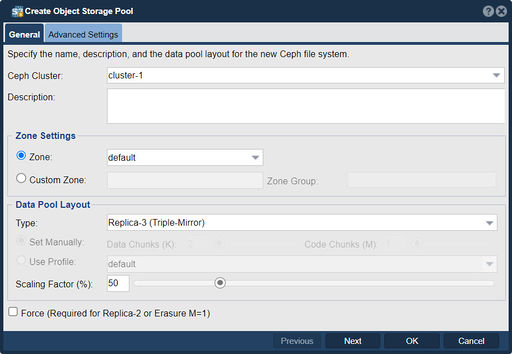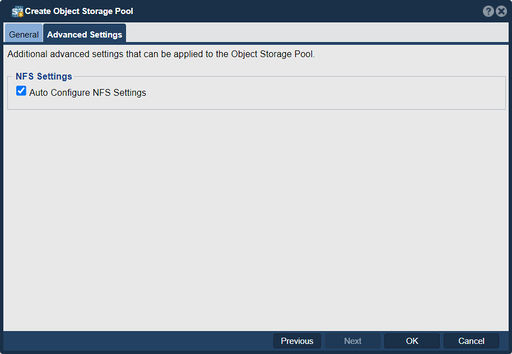Difference between revisions of "Ceph Object Zone Create"
m |
m |
||
| (26 intermediate revisions by the same user not shown) | |||
| Line 1: | Line 1: | ||
| − | + | [[File:Create Obj Strg Pool - General.jpg|512px|thumb|Create a logical container for storing and managing object-based data.]] [[File:Create Obj Strg Pool - Adv Settings.jpg|512px|thumb|Configure NFS Settings.]] | |
| + | QuantaStor is a software-defined storage (SDS) platform developed by OSNexus. It provides a range of storage management features and capabilities, including the ability to create object storage pools. | ||
| − | + | The purpose of creating an object storage pool in QuantaStor is to establish a logical container for storing and managing object-based data. Object storage is a storage architecture that stores data as objects, each with a unique identifier, metadata, and data content. It is commonly used for large-scale and unstructured data, such as media files, backups, archives, and cloud-native applications. | |
| + | By creating an object storage pool in QuantaStor, you can: | ||
| − | + | *Consolidate Storage: Object storage pools enable you to consolidate multiple storage devices or systems into a single logical pool. This consolidation simplifies management and provides a unified view of the underlying storage resources. | |
| + | |||
| + | *Scalability: Object storage pools can scale horizontally by adding additional storage devices or nodes to the pool. This allows you to seamlessly expand your storage capacity as your data grows without disrupting ongoing operations. | ||
| + | |||
| + | *Data Protection: QuantaStor's object storage pools typically incorporate data protection mechanisms, such as data redundancy and erasure coding. These techniques ensure data durability and availability even in the event of disk failures or node outages. | ||
| + | |||
| + | *Metadata Management: Object storage pools store metadata alongside the actual data objects. This metadata can include information such as file names, timestamps, and user-defined tags. Efficient management of metadata allows for enhanced search, indexing, and retrieval capabilities. | ||
| + | |||
| + | *Access Control and Security: QuantaStor offers access control mechanisms to secure the object storage pools. You can define access permissions, authentication methods, and encryption protocols to safeguard data and restrict unauthorized access. | ||
| + | |||
| + | *Integration with Object Storage APIs: Object storage pools in QuantaStor are typically compatible with industry-standard object storage APIs, such as Amazon S3 or OpenStack Swift. This compatibility enables seamless integration with various applications and services that rely on object storage interfaces. | ||
| + | |||
| + | In summary, creating an object storage pool in QuantaStor allows you to leverage the benefits of object storage, such as scalability, data protection, and flexible access methods, while providing a centralized and manageable storage infrastructure for your organization's needs. | ||
| + | |||
| + | |||
| + | '''Navigation:''' Scale-out Storage Configuration --> Scale-out Storage Pools --> Object Storage --> Create Object Storage Pool ''(toolbar)'' | ||
{{Template:ReturnToWebGuide}} | {{Template:ReturnToWebGuide}} | ||
| − | [[Category: | + | [[Category:QuantaStor6]] |
[[Category:WebUI Dialog]] | [[Category:WebUI Dialog]] | ||
[[Category:Requires Review]] | [[Category:Requires Review]] | ||
Latest revision as of 11:41, 10 June 2023
QuantaStor is a software-defined storage (SDS) platform developed by OSNexus. It provides a range of storage management features and capabilities, including the ability to create object storage pools.
The purpose of creating an object storage pool in QuantaStor is to establish a logical container for storing and managing object-based data. Object storage is a storage architecture that stores data as objects, each with a unique identifier, metadata, and data content. It is commonly used for large-scale and unstructured data, such as media files, backups, archives, and cloud-native applications.
By creating an object storage pool in QuantaStor, you can:
- Consolidate Storage: Object storage pools enable you to consolidate multiple storage devices or systems into a single logical pool. This consolidation simplifies management and provides a unified view of the underlying storage resources.
- Scalability: Object storage pools can scale horizontally by adding additional storage devices or nodes to the pool. This allows you to seamlessly expand your storage capacity as your data grows without disrupting ongoing operations.
- Data Protection: QuantaStor's object storage pools typically incorporate data protection mechanisms, such as data redundancy and erasure coding. These techniques ensure data durability and availability even in the event of disk failures or node outages.
- Metadata Management: Object storage pools store metadata alongside the actual data objects. This metadata can include information such as file names, timestamps, and user-defined tags. Efficient management of metadata allows for enhanced search, indexing, and retrieval capabilities.
- Access Control and Security: QuantaStor offers access control mechanisms to secure the object storage pools. You can define access permissions, authentication methods, and encryption protocols to safeguard data and restrict unauthorized access.
- Integration with Object Storage APIs: Object storage pools in QuantaStor are typically compatible with industry-standard object storage APIs, such as Amazon S3 or OpenStack Swift. This compatibility enables seamless integration with various applications and services that rely on object storage interfaces.
In summary, creating an object storage pool in QuantaStor allows you to leverage the benefits of object storage, such as scalability, data protection, and flexible access methods, while providing a centralized and manageable storage infrastructure for your organization's needs.
Navigation: Scale-out Storage Configuration --> Scale-out Storage Pools --> Object Storage --> Create Object Storage Pool (toolbar)

